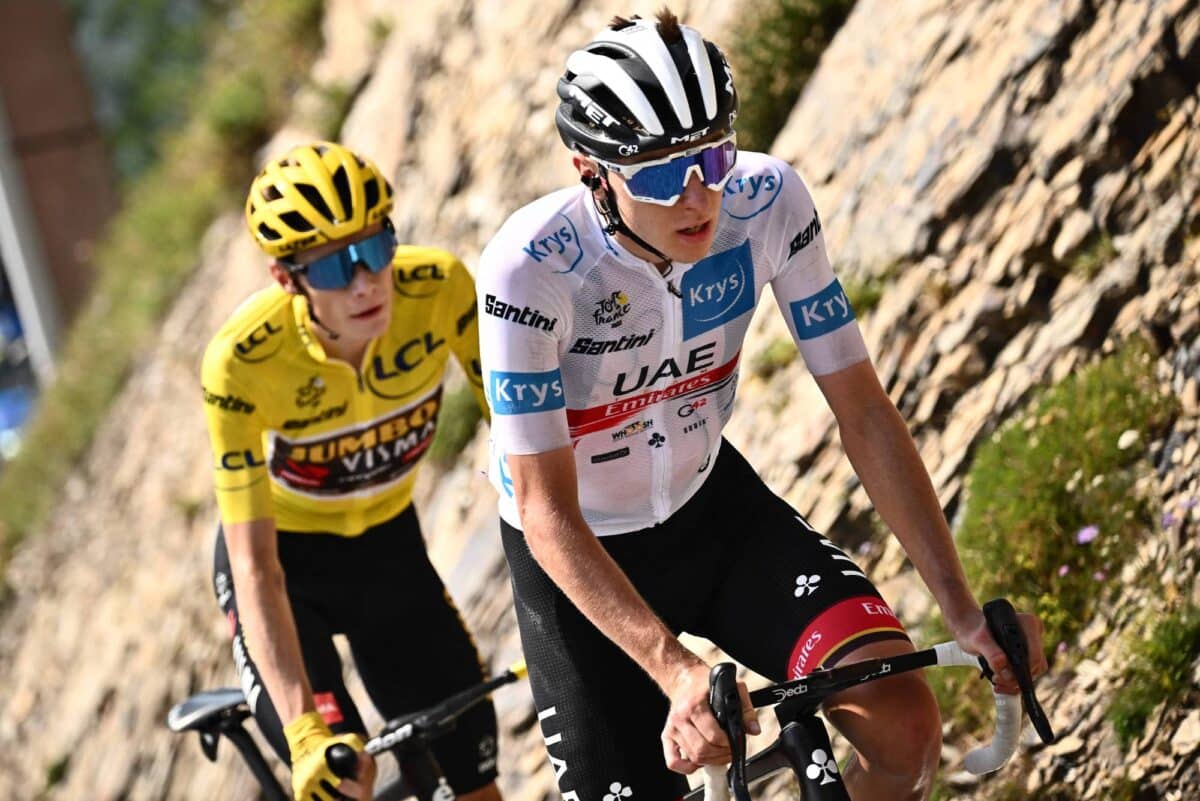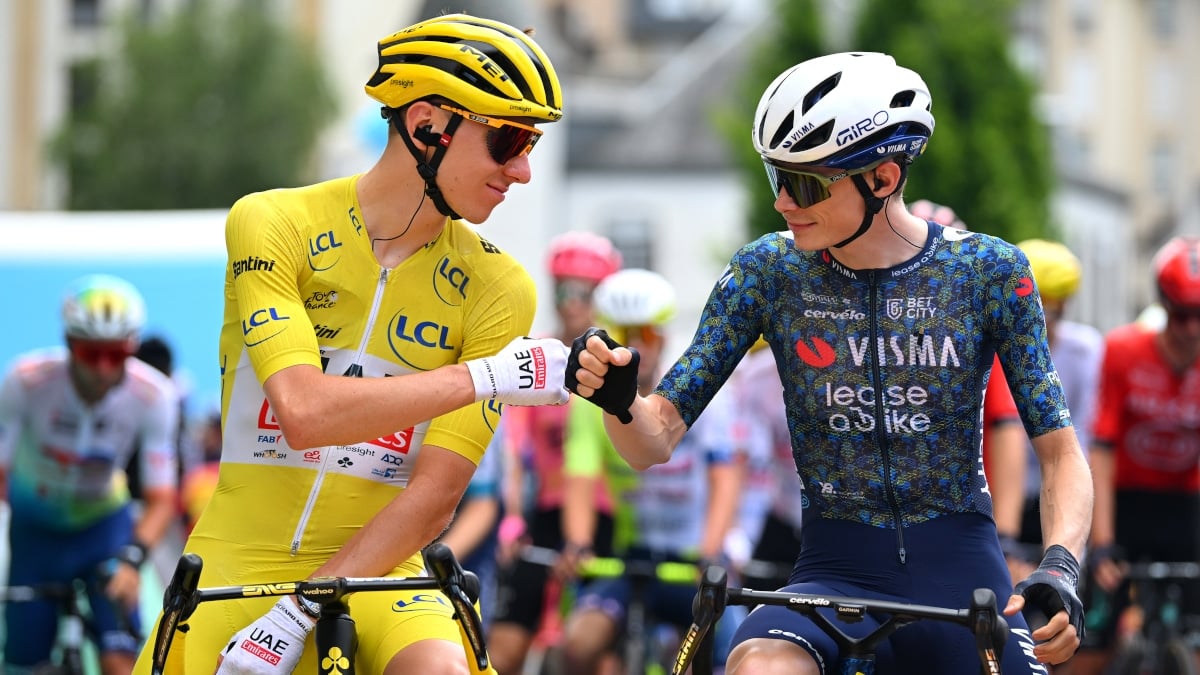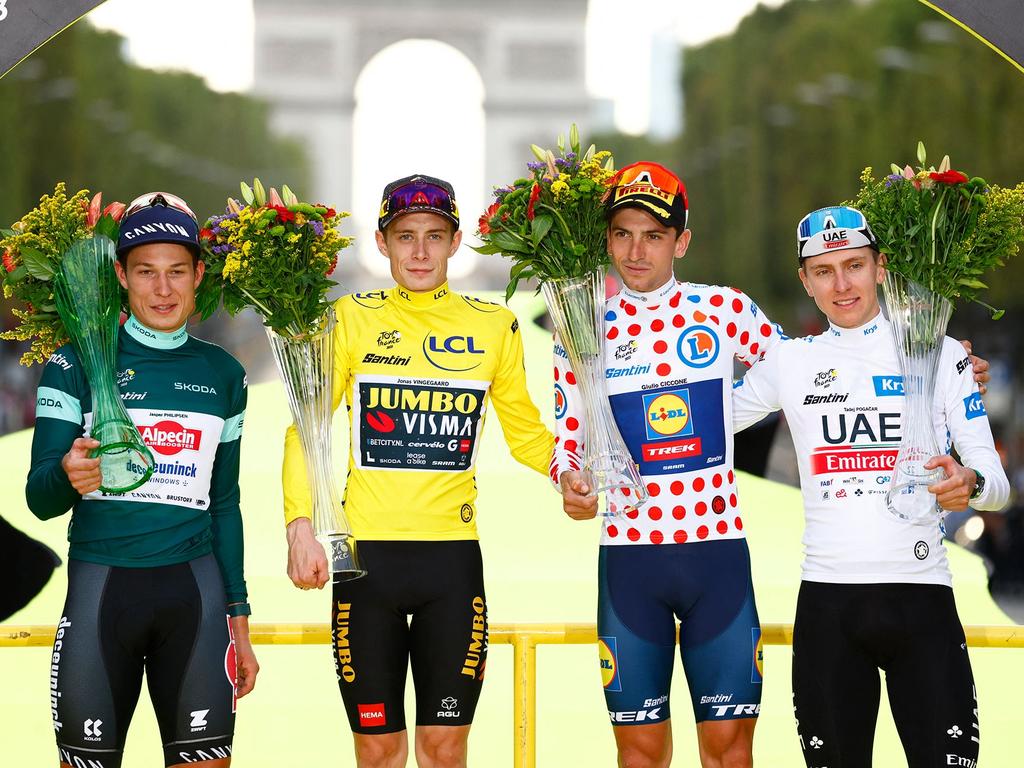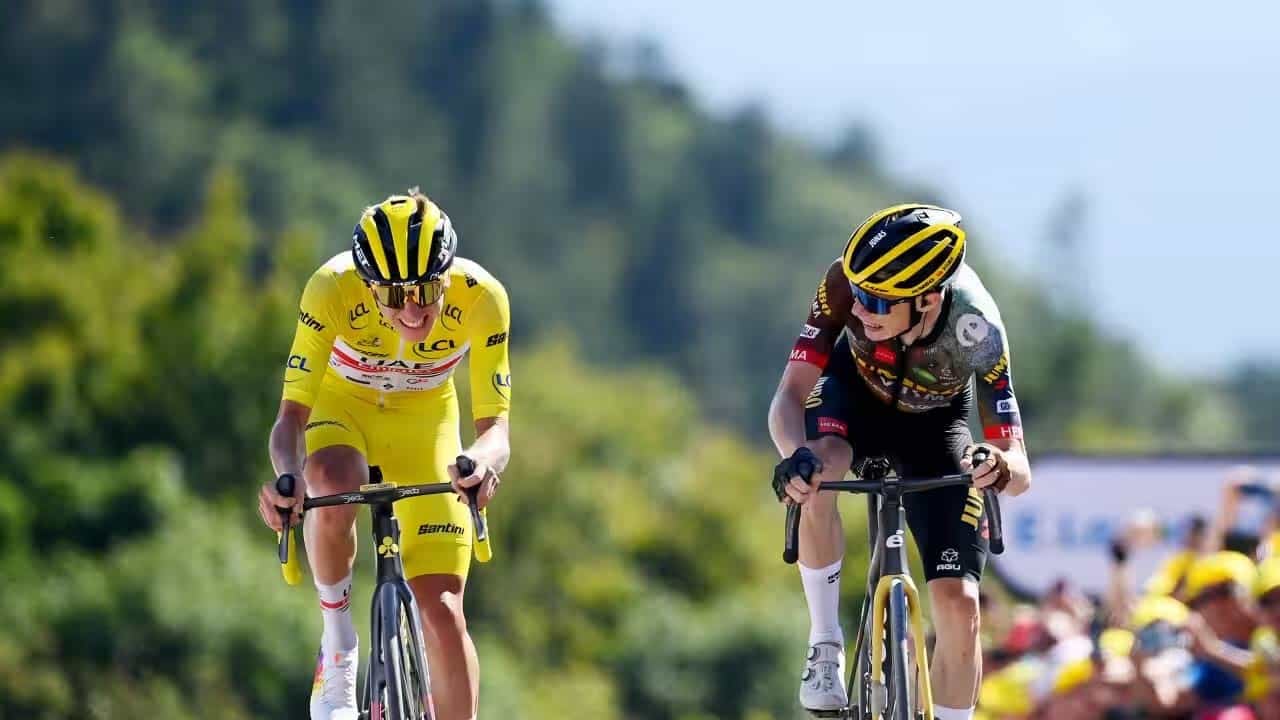The greatest rivalry in Tour de France cycling today belongs to Tadej Pogacar and Jonas Vingegaard. These cycling giants have dominated the General Classification's top two spots for four straight Tours. Most recently, Pogacar grabbed his third yellow jersey in 2024 with an impressive 6:17 lead over Vingegaard, built primarily through four mountain-top finishes. Remco Evenepoel secured third place, 9:18 behind the Slovenian champion, but the spotlight stayed on cycling's premier showdown.
This year's Tour will take this rivalry to new heights. The 2025 route features an incredible 52,500 meters of total climbing and five mountain-top finishes. This climber's dream course suits both competitors perfectly. Pogacar stands as the favourite after beating Vingegaard by 59 seconds at the recent Critérium du Dauphiné. Yet the Danish champion's back-to-back Tour wins in 2022 and 2023 show his ability to perform best during the main event. Pogacar's achievements at just 26 years old are remarkable - three Tour titles, a Giro d'Italia victory, and numerous prestigious one-day race wins. Still, Vingegaard knows how to challenge cycling's most explosive talent under the right conditions.

Tadej Pogacar wearing the best young rider's white jersey and Jonas Vingegaard wearing the overall leader's yellow jersey cycle during the 2022 edition of the Tour de France. (Photo by Marco BERTORELLO / AFP)
The 2025 Tour de France route features some of the most challenging terrain in cycling. The organizers revealed the route last October in Paris and this edition clearly favours pure climbers which should set up another epic battle between Pogacar and Vingegaard.
The six high-altitude summit finishes will shape the general classification battle. Recent editions only had three or four mountain-top finishes, but 2025 takes the vertical challenge to another level. Each high-altitude finish stands above 1,800 meters where the thin-air will make oxygen debt just as vital as power output. Stages 12, 14, 16, 18 and 19 all end at elevation. Riders must stay in peak form through three grueling weeks and the hungry general classification athletes are spending the lead up at altitude training camps.
The 2025 route balances its mountain tests with just 44km of time trialing split between two stages. Stage 5 opens the time trialing portion with a flat 33km individual effort that will create early rankings and may favour Remco Evenpoel, currently both the World and Olympic Time Trial Champion. The second time trial comes on stage 13 and is an 11km blast uphill will favour riders with a high watts/kg ratio. The second time trial could prove decisive but demands exceptional recovery after multiple mountain stages.
The route's most feared mountains takes in many names you have certainly heard if you've ever watched the Tour de France. Mont Ventoux makes its return with its lunar landscape and relentless gradients on stage 16. Hautacam hosts the stage 12 finale on the same climb where Vingegaard broke Pogacar in 2022. The Col de la Loze marks the tour's highest point at 2,304 meters on stage 18 and where Tadej Pogacar once uttered the words "I'm gone. I'm dead". Its brutal 24% ramps in the final kilometers will test every rider's limits.
The total elevation gain of 52,500 meters is about 3,000 meters more than the 2024 edition. Riders will climb nearly 2,500 meters each day across 21 stages. This equals climbing Mount Olympus daily for three weeks.
The Tour's top contenders show a clear difference in their current form as we head into July. Their recent performances hint at who might lead the pack.
The 2025 Critérium du Dauphiné gave us the first major showdown between cycling's giants since last year's Tour. Pogacar beat Vingegaard by 59 seconds and won three of eight stages, including the queen stage to Valmeinier. Pogacar seemed to hold back power and still gained time in the final kilometers of mountain stages. Brian Holm, former Quick-Step director, said "It didn't even look like Pogacar was going full gas—whereas Vingegaard said he was putting out his best numbers ever".
Pogacar dominated the spring classics with remarkable versatility while Vingegaard focused on recovery. Pogacar won Strade Bianche, Tour of Flanders, La Fleche Wallonne, and Liege-Bastogne-Liege. The Slovenian matched Eddy Merckx as the only riders to win both Tour of Flanders and Liege-Bastogne-Liege in one year. The classics riders are typically not Tour contenders, but Tadej's form may make it tempting to attack on the numerous hilly stage profiles as well as the big mountain finishes.
Both contenders headed back to altitude training after the Dauphiné. Vingegaard started his Tour prep with wind tunnel testing in Aalborg, Denmark, then moved to Sierra Nevada for team altitude training. Visma planned a second altitude camp in Tignes after the Dauphiné. Visma stays confident despite Vingegaard's light race schedule - just two full stage races before the Tour. Coach Tim Heemskerg said, "We know this approach works for him".
A crash during Paris-Nice on March 13 disrupted Vingegaard's 2025 preparations. He suffered a concussion and missed the Volta a Catalunya. Vingegaard explained, "I was dizzy after the crash, and afterward I got very nauseous and was incredibly tired, which continued for several days". He bounced back completely and said, "I no longer have any issues from the concussion I sustained earlier, or any other physical problems".

Tadej Pogacar and Jonas Vingegaard prior to Stage 12 of the 2024 Tour de France (Photo by Dario Belingheri/Getty Images)
The rivalry between UAE Team Emirates and Visma-Lease a Bike goes beyond individual riders. Their support teams might be the key factor that shapes the tour de france predictions.
Pogačar heads to the Grand Départ with a powerhouse support team. João Almeida and Adam Yates stand out as his main allies. Almeida comes fresh from impressive wins at Itzulia Basque Country and Tour de Romandie. Yates proved his worth last year by securing third place in the Tour while backing his Slovenian leader. The team has more tactical firepower with Marc Soler, Pavel Sivakov, and Tim Wellens. This all-star lineup specializes in mountain stages and will endeavour to keep Pogačar safe through the tour's toughest terrain.
Vingegaard's support team looks just as impressive - maybe even stronger. Matteo Jorgenson, who finished eighth in last year's Tour, is back as a vital lieutenant. Wout van Aert, who might be cycling's most versatile rider, offers crucial protection on flat and rolling terrain. The team rides high on momentum after Simon Yates' recent Giro d'Italia victory. He grabbed the pink jersey with a spectacular show on the Colle delle Finestre. This powerful quartet gives Vingegaard plenty of tactical options, especially in the mountains.
A domestique's job exceeds simple support. Their job is to anticipate everything for their leader. Super-domestiques protect leaders from wind, fetch supplies, guard positions, and save their leader's energy for key moments. The last helper standing on brutal climbs - likely Almeida for UAE or Jorgenson for Visma - will shape the general classification battle. Their ability to put team goals first ends up determining success.
UAE has sometimes leaned too much on Pogačar's brilliance instead of team tactics. Visma takes a different approach by attempting to control the pace with multiple strong climbers to isolate their rivals. Last year showed these contrasting styles when UAE sent Yates into a breakaway. This move forced Visma to chase and burn energy. This tactical chess match between team directors can matters just as much as the physical battle between leaders.

The top two riders' mountain strategies show fundamental differences. Pogacar's explosive bursts have troubled Vingegaard time and again—this showed during stage 17 of the 2024 Tour when Pogacar attacked hard on Col du Noyer and immediately opened gaps. In 2025, Pogacar has favoured the seated attack and once again used it to great effect in the Criterium du Dauphine to drop Vingegaard. Vingegaard runs on steady, high-threshold efforts across long climbs. The Dane must get better at matching Pogacar's sudden accelerations, instead of just following, to challenge for the yellow jersey in 2025.
The 2023 time trial at Combloux showed Vingegaard's potential dominance against the clock. He beat Pogacar by 1:38 and rode at an incredible 41.2kph average. On top of that, Pogacar lost 49 seconds to Evenepoel and almost 30 seconds to Vingegaard over just 17.4km at the 2025 Dauphiné. People still debate if this was a tactical bluff or real weakness as Pogacar didn't appear to be going full gas. Time in the wind tunnel could also be important, especially on the flat time trial in Stage 5.
The 2025 route brings back mountains where Pogacar struggled before. One analyst said, "It's almost as if they want to remind everyone that the Slovenian is fallible". Mont Ventoux (where Vingegaard first dropped Pogacar in 2021), Hautacam (where he united his 2022 victory), and Col de la Loze (previously mentioned) all make a comeback. These battlegrounds carry heavy psychological weight, but the last two years have belonged to Pogacar and he will enter the race feeling very confident.
Stage 18 stands out as the queen stage with 5,500m of vertical gain that ends on Col de la Loze. Stage 16 on Mont Ventoux might be just as decisive and has favoured Vingegaard in the past. The Hautacam summit finish on stage 12 (13.6km at 7.8%) offers another key battleground. Tactical superiority, not just pure physical strength, will determine who wears the yellow jersey.

The upcoming Tour de France shapes up as the most exciting Grand Tour we've seen in years. Pogacar and Vingegaard have built a rivalry that takes us back to cycling's golden eras. Their power numbers are pushing the boundaries of what we thought possible. These two couldn't be more different in their approach - Pogacar attacks with explosive bursts while Vingegaard methodically sets his pace. This creates perfect drama over the three-week race.
Pogacar looks ready to win after dominating the Dauphiné and spring classics. Yet Vingegaard knows how to peak just in time for July. His Tour victories in 2022 and 2023 came after quiet build-ups that didn't hint at his true form. This pattern suggests he might surprise us again.
The punishing 2025 route adds another fascinating dimension. It features the same climbs where Vingegaard broke Pogacar before. Col de la Loze stands out as a defining challenge - the very place where Pogacar famously said "I'm gone, I'm dead" while dropping nearly six minutes in 2023.
Team strength will decide much of this battle. UAE Team Emirates brings what might be their strongest Tour lineup ever. Almeida and Yates provide vital support in the high mountains. Vingegaard's Visma-Lease a Bike matches this firepower with Van Aert's versatility and Jorgenson's climbing expertise.
Weather could play a big role in the final result. Pogacar performs better in extreme heat, while Vingegaard runs on cooler temperatures. The Alps' unpredictable weather patterns might end up deciding who stands on top in Paris.
This Tour means more than just another yellow jersey. A fourth Tour victory would put Pogacar among cycling's greatest riders at just 26. Vingegaard wants to prove his previous wins weren't lucky breaks but showed he belongs at the top of the sport.
The 2025 Tour de France promises both spectacular racing and a place in cycling history. Whatever the outcome, fans worldwide will watch what could become the defining chapter in cycling's most gripping modern rivalry. Our money is on Pogacar for 2025.
